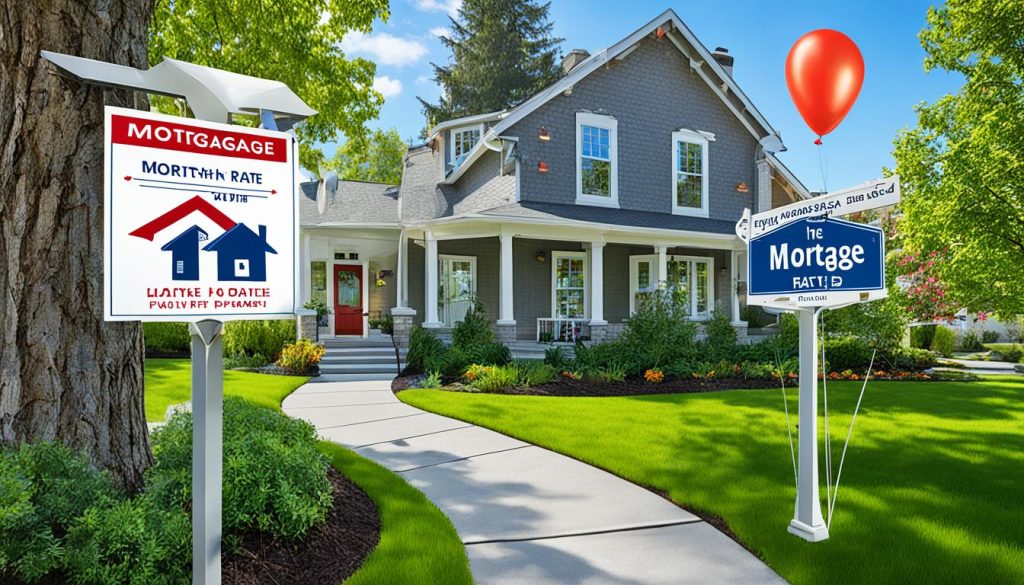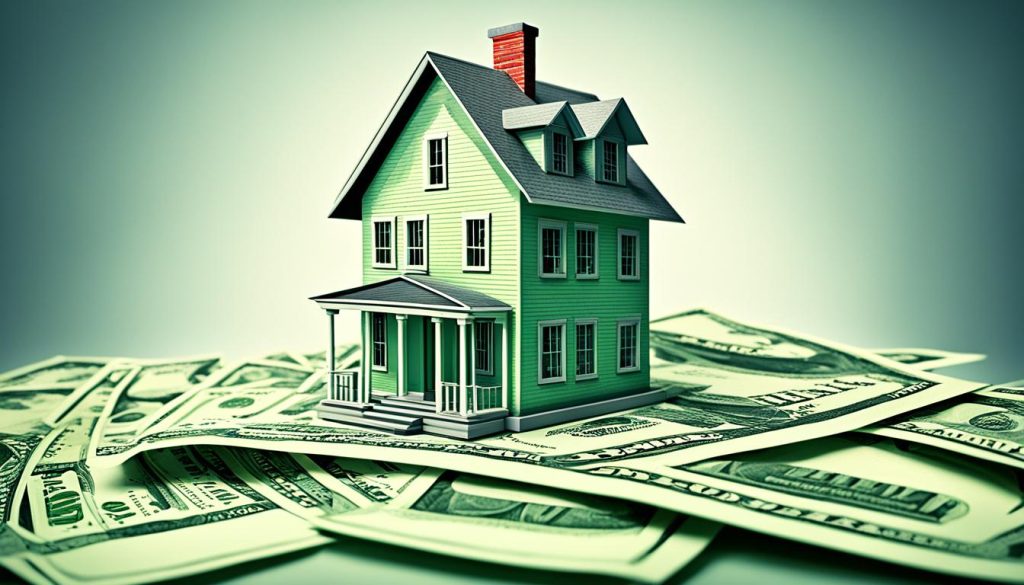Homebuyers today face a choice between fixed-rate and adjustable-rate mortgages (ARMs) when financing their home purchase. Fixed-rate mortgages have an interest rate that remains the same throughout the loan’s term, providing stability and predictability in monthly payments1. ARMs, on the other hand, have an interest rate that can fluctuate over time based on broader market trends. This article explores the key differences between fixed-rate and adjustable-rate mortgages, helping you determine which option is the best fit for your home financing needs.
Key Takeaways
- Fixed-rate mortgages offer predictable monthly payments, while ARMs have variable rates that can change over time.
- Fixed-rate mortgages are generally preferred by borrowers who plan to stay in their homes for the long term.
- ARMs may be suitable for short-term homeowners or those who expect their income to increase in the future.
- Understanding the pros and cons of each mortgage type is crucial in making an informed decision.
- Consulting with a financial professional can help you determine the best mortgage option for your unique circumstances.
Understanding Fixed-Rate and Adjustable-Rate Mortgages
Fixed-Rate Mortgages: Stable Payments for Life
Fixed-rate mortgages offer a unique advantage – their interest rate remains unchanged throughout the entire loan term, typically 30 or 15 years2. This means your monthly principal and interest payments will stay the same each month, providing predictability and making budgeting easier. The main benefit of a fixed-rate loan is that the borrower is protected from sudden increases in monthly payments if interest rates rise2. However, if interest rates decline, you would need to refinance to take advantage of lower rates, which would incur closing costs.
Adjustable-Rate Mortgages (ARMs): Variable Rates
In contrast, adjustable-rate mortgages (ARMs) have an interest rate that can change over time based on broader market trends2. ARMs typically start with a lower initial interest rate compared to fixed-rate loans, but this rate can increase or decrease at specific intervals, such as annually or every six months, after an initial fixed-rate period of 3, 5, 7, or 10 years23. ARMs come with various caps that limit the amount the interest rate can change, both per adjustment and over the lifetime of the loan23.
“ARMs may be a better option if you intend to live in a home for a short period or expect to make more income in the future.”3
Adjustable-rate mortgages (ARMs) are typically 30-year loans, with initial fixed-rate periods commonly being 7 and 10 years3. ARM introductory rates are typically lower than average fixed mortgage interest rates3. ARMs have different interest rate adjustment structures, such as 5/1 ARMs, where the first number represents the fixed interest rate period and the second number indicates how often the rate changes3.
Both ARMs and fixed-rate mortgages have similar term length options, including commonly offered 30-year terms3. Credit scores play a significant role in qualifying for both ARMs and fixed-rate mortgages, with a score of 700 or above considered good324.
Key Differences Between Fixed-Rate and Adjustable-Rate Mortgages
When it comes to mortgages, the primary distinction between fixed-rate and adjustable-rate (ARM) loans lies in the nature of their interest rates5. Fixed-rate mortgages maintain a consistent interest rate throughout the loan term, leading to predictable monthly payments until the loan is paid off, refinanced, or the home is sold, unlike adjustable-rate mortgages5. ARMs, on the other hand, have an initial fixed period with lower introductory rates, followed by an adjusted period where rates can fluctuate once or twice a year5.
To illustrate, a 5/1 ARM has a fixed interest rate for the first five years, followed by annual rate adjustments5. Choosing a 5/1 ARM over a fixed-rate mortgage at a lower initial rate could save approximately $67,000 in interest payments over the loan term5. However, fixed-rate mortgages provide stability and ease of budgeting with consistent monthly payments, while ARMs can create variability in payments during the adjusted period5.
Lenders often have more relaxed borrower requirements for ARMs due to the initial lower payments compared to fixed-rate mortgages5. Fixed-rate mortgages typically come with higher interest rates but offer security with a fixed rate, potentially worth the higher upfront cost if rates rise in the future5. Both types of mortgages offer 15-year and 30-year terms for borrowers, with options for refinancing available to switch between fixed and adjustable rates5.
Adjustable-rate and fixed-rate mortgages are offered by major lenders, allowing borrowers to compare costs and benefits conveniently5. Choosing between a fixed-rate and adjustable-rate mortgage should be based on financial goals and long-term housing plans, with factors like length of stay in the home and rate expectations influencing the decision5.

Interestingly, in the United States, fixed-rate mortgages are more popular compared to adjustable-rate mortgages, while countries like the United Kingdom, Australia, and New Zealand show a higher preference for variable rate mortgages over fixed-rate mortgages6. This difference in preference can be attributed to factors such as interest rate trends, regulatory environments, and cultural attitudes toward risk6.
| Metric | Fixed-Rate Mortgage | Adjustable-Rate Mortgage (ARM) |
|---|---|---|
| Interest Rate | Consistent throughout the loan term | Initial fixed period, then adjusts periodically |
| Initial Interest Rate | Usually higher than ARM | Usually lower than fixed-rate |
| Payment Stability | Predictable monthly payments | Payments can fluctuate over time |
| Loan Terms | Typical terms: 15 or 30 years | Typical terms: 15 or 30 years |
| Refinancing | Option to refinance to different loan type | Option to refinance to different loan type |
| Borrower Requirements | May have stricter requirements | May have more relaxed requirements |
In the United States, the traditional 30-year fixed-rate mortgage is the most popular type of mortgage, and most mortgages are fixed-rate loans7. Adjustable-rate mortgages typically have initial fixed-rate periods of 3, 5, 7, or 10 years, and their interest rates usually start lower than fixed-rate loan rates7. However, ARM loans could reset higher several times over the life of the loan, increasing mortgage payments7.
Fixed-rate mortgages are often recommended for those planning to own a home for the long term, as they provide the benefit of a locked-in rate and ensure a stable monthly payment7. Adjustable-rate mortgages, on the other hand, are more appealing to first-time homebuyers due to lower rates and enhanced buying power, though they may be suitable if the homeowner plans to move or upgrade to a larger home before the fixed-rate period ends7.
“When choosing between an ARM and a fixed-rate mortgage, consider how long you plan to own the home and the stability of your income.”7
By understanding the key differences between fixed-rate and adjustable-rate mortgages, you can make an informed decision that aligns with your financial goals and long-term housing plans.
Fixed-Rate vs. Adjustable-Rate: Initial Interest Rates
When it comes to mortgages, the initial interest rate is a crucial factor to consider when choosing between a fixed-rate or an adjustable-rate mortgage (ARM). Generally, ARMs tend to have a lower introductory interest rate compared to fixed-rate loans, which can translate to lower monthly payments during the initial period8. However, this advantage can be short-lived, as the ARM’s interest rate may increase or decrease based on market conditions after the fixed-rate period ends, potentially leading to higher payments in the future8.
Conversely, fixed-rate mortgages offer a consistent interest rate and monthly payment throughout the loan’s term, providing borrowers with the stability and predictability they may prefer1. This can be particularly beneficial for those planning to own their home long-term or those who value the ability to accurately budget their monthly expenses1.
It’s important to note that the initial interest rate differential between ARMs and fixed-rate mortgages can be quite significant8. According to recent data, ARMs have charged as much as a full percentage point less than fixed mortgages in the recent past9. This gap can make a noticeable difference in monthly payments, especially for larger loan amounts.
| Mortgage Type | Initial Interest Rate | Monthly Payment (on $300,000 loan) |
|---|---|---|
| Fixed-Rate | 6.25% | $1,852 |
| Adjustable-Rate (5/1 ARM) | 5.25% | $1,658 |
The above table illustrates the potential savings in monthly payments that an ARM could offer in the initial years compared to a fixed-rate mortgage8. However, it’s crucial to consider the long-term implications and the risks associated with adjustable-rate mortgages, as the interest rate and monthly payments may fluctuate significantly over the life of the loan.
Ultimately, the choice between a fixed-rate or adjustable-rate mortgage should be based on your individual financial situation, goals, and risk tolerance. Carefully evaluating the tradeoffs between the initial interest rates, potential future rate changes, and your long-term plans can help you make an informed decision that aligns with your unique needs918.
Interest Rate Stability: The Pros and Cons
When it comes to mortgages, the choice between a fixed-rate loan and an adjustable-rate mortgage (ARM) often boils down to the tradeoff between interest rate stability and potential savings. Both options have their own set of benefits and drawbacks that homebuyers should carefully consider.
Fixed-Rate Mortgage Benefits
The primary advantage of a fixed-rate mortgage is the predictability and consistency it provides. With a fixed-rate loan, your monthly principal and interest payment remains the same for the life of the loan, typically 30, 20, or 15 years10. This makes it easier to budget and plan your finances, particularly for homeowners who plan to stay in their home for the long term or have a fixed income.
Another benefit of fixed-rate mortgages is that if market interest rates decrease after you’ve obtained your loan, you can refinance to take advantage of the lower rates10. However, refinancing will incur closing costs, which should be factored into the decision.
ARM Advantages and Risks
Adjustable-rate mortgages (ARMs) offer the advantage of a lower initial interest rate compared to fixed-rate loans1011. This can result in more affordable monthly payments during the introductory period, which can be beneficial for homebuyers who plan to move or refinance before the ARM’s interest rate adjusts or for those who expect their income to increase in the future.
However, ARMs also carry the risk of higher monthly payments if interest rates rise1011. This can make budgeting and financial planning more challenging for borrowers, especially if they plan to remain in the home long-term9. Additionally, ARMs typically require a higher down payment of at least 5 percent, compared to 3 percent for a conventional fixed-rate loan, making them slightly more challenging to qualify for9.
Ultimately, the choice between a fixed-rate mortgage and an adjustable-rate mortgage depends on your financial goals, risk tolerance, and the length of time you plan to stay in your home. Careful consideration of the pros and cons of each option can help you make the best decision for your specific situation.
“Adjustable-rate mortgages may be beneficial for borrowers planning to stay in a home for fewer than 10 years or those who can pay off the entire loan before higher rates apply.”11
Rate Caps and Mortgage Affordability
When considering an adjustable-rate mortgage (ARM), it’s crucial to understand the rate caps that limit the amount your interest rate can increase or decrease. ARMs often feature initial adjustment caps, subsequent adjustment caps, and lifetime caps to protect borrowers from sudden and significant payment fluctuations12. These caps help ensure your monthly payments don’t skyrocket unexpectedly, making your mortgage more affordable over time.
However, even with these rate caps, an ARM’s interest rate and monthly payment can still vary, potentially impacting the overall affordability of your mortgage, especially if you’re on a tight budget13. It’s important to carefully evaluate your financial situation and ability to handle potential payment changes before choosing an ARM over a fixed-rate mortgage.
Adjustable-rate mortgages typically start with a lower fixed-rate period before transitioning to variable rates that are reassessed regularly14. This initial lower interest rate can lead to cost savings, especially in the early years of the loan. But as the rate adjusts, your monthly payments may increase, potentially straining your budget if your income doesn’t keep pace.
To ensure your ARM remains affordable, consider the frequency of rate adjustments and potential future interest rate trends13. Evaluate how long you plan to stay in the home and whether you expect your earnings to rise in the coming years13. Adjustable-rate mortgages may be suitable if you anticipate increased income, but fixed-rate mortgages offer more stability for those with a fixed budget.
| Metric | Fixed-Rate Mortgage | Adjustable-Rate Mortgage (ARM) |
|---|---|---|
| Interest Rate Stability | Fixed for the life of the loan | Fluctuates over time |
| Initial Interest Rate | Higher than ARM | Lower than fixed-rate |
| Monthly Payments | Consistent throughout the loan | May increase after fixed-rate period |
| Rate Caps | Not applicable | Limit interest rate changes |
| Potential Savings | Possible if rates decrease, but must refinance | Possible in early years due to lower initial rate |
When choosing between a fixed-rate mortgage and an ARM, carefully consider your financial goals, risk tolerance, and the potential impact of rate fluctuations on your monthly budget13. By understanding the rate caps and affordability considerations, you can make an informed decision that aligns with your long-term housing and financial needs.

“With ARMs, be prepared for potential monthly payment fluctuations as interest rates adjust. Consider personal financial stability when choosing between fixed-rate and adjustable-rate mortgages.”13
Fixed-Rate vs. Adjustable-Rate: Which to Choose?
When it comes to selecting a mortgage, the choice between a fixed-rate or an adjustable-rate (ARM) loan can significantly impact your financial future. To make an informed decision, it’s crucial to consider your personal financial situation, interest rate trends, and your long-term plans for the property15.
If you value payment stability and predictability, a fixed-rate mortgage may be the better option, especially if you believe interest rates will rise in the future. Fixed-rate mortgages typically come with a fixed interest rate that remains constant throughout the loan term.5 This ensures your monthly payments will stay the same, making it easier to budget and plan for the life of the loan.
On the other hand, an ARM may be more suitable if you plan to live in the home for a shorter period, expect your income to increase, or believe interest rates will decline. Adjustable-rate mortgages (ARMs) usually start with a lower introductory rate for a fixed period, after which the rate adjusts periodically.5 While this can lead to lower initial payments, the unpredictability of future rate changes can be a significant drawback for some borrowers.
To illustrate the differences, let’s consider a $400,000 home with a 20% down payment. For a fixed-rate mortgage with a 5% interest rate, the monthly payments would be around $1,700.5 In contrast, choosing a 5/1 ARM at a lower initial interest rate of 3.75% would result in starting payments of approximately $1,500 for the first five years.5 However, the ARM’s rate could potentially adjust higher after the introductory period, impacting your monthly budget.
Ultimately, the best choice between a fixed-rate or adjustable-rate mortgage depends on your personal financial situation, interest rate trends, your loan term, and your future plans for the property. Careful evaluation of the pros and cons of each option is essential to determine the best fit for your homebuying needs.15

“Choosing between a fixed-rate and an adjustable-rate mortgage should be based on financial goals and long-term housing plans.”5
To make an informed decision, it’s recommended to compare mortgage offers from multiple lenders and consider factors such as interest rates, loan terms, and fees. By weighing your options carefully, you can choose the mortgage that aligns best with your personal and financial circumstances.
Conclusion
When it comes to the fixed-rate vs. adjustable-rate mortgage decision, there is no one-size-fits-all solution. Your personal financial considerations, future plans, and risk tolerance will play a crucial role in determining the right mortgage for your homebuying needs16.
If you value payment stability and predictability, a fixed-rate mortgage may be the better option, especially if you intend to stay in your home for more than 10 years17. On the other hand, an adjustable-rate mortgage could benefit those who plan to move or refinance within a few years, as the lower introductory rates can lead to potentially lower monthly housing payments during the fixed-rate period1617.
Regardless of your choice, it’s crucial to carefully evaluate the interest rate caps, potential for payment fluctuations, and your overall financial profile, including credit score18, debt-to-income ratio16, and employment stability18. By understanding the nuances of fixed-rate vs. adjustable-rate mortgages, you can make an informed decision that aligns with your personal financial considerations and home financing objectives.
FAQ
What is the difference between fixed-rate and adjustable-rate mortgages?
The primary difference is the nature of their interest rates. Fixed-rate mortgages have an interest rate that remains the same throughout the loan’s term, while adjustable-rate mortgages (ARMs) have an interest rate that can fluctuate over time based on market conditions.
What are the advantages of a fixed-rate mortgage?
The main advantage of a fixed-rate loan is the stability and predictability it provides. Your monthly principal and interest payment remains the same for the life of the loan, making it easier to budget and plan your finances.
What are the benefits of an adjustable-rate mortgage?
Adjustable-rate mortgages (ARMs) typically have a lower initial interest rate compared to fixed-rate loans, resulting in more affordable monthly payments during the introductory period. This can be beneficial for homebuyers who plan to move or refinance before the ARM’s interest rate adjusts or for those who expect their income to increase.
How do rate caps work with adjustable-rate mortgages?
ARMs come with various rate caps that limit the amount the interest rate can increase or decrease, both per adjustment and over the lifetime of the loan. These caps help protect borrowers from sudden and significant payment increases.
How do I decide between a fixed-rate or adjustable-rate mortgage?
Consider your personal financial situation, including your budget, income stability, and future plans for the property. If you value payment stability and predictability, a fixed-rate mortgage may be the better choice. An ARM may be more suitable if you plan to live in the home for a shorter period, expect your income to increase, or believe interest rates will decline in the future.
Source Links
- Fixed-Rate Mortgage vs. ARM: How Do They Compare?
- Fixed vs. Adjustable-Rate Mortgage: What’s the Difference?
- Fixed- Vs. Adjustable-Rate Mortgage (ARM): What’s The Difference?
- Fixed vs. Adjustable-Rate Mortgages: What’s the Difference? | Bankrate
- Fixed-Rate Vs. Adjustable-Rate Mortgage: What’s The Difference?
- Adjustable Rate Mortgage vs Fixed Rate Mortgage – Difference and Comparison
- Comparing ARMs vs. Fixed Rate Mortgages – NerdWallet
- Fixed-Rate vs. Adjustable-Rate Mortgage: What’s the Difference? – Experian
- Pros And Cons Of An Adjustable-Rate Mortgage (ARM) | Bankrate
- Pros and Cons: Fixed-Rate vs. Adjustable-Rate Mortgage Loans
- Fixed-rate vs. adjustable-rate mortgages. Which is best for you? | First Financial Bank
- Should You Get a Fixed Rate or Adjustable Rate Mortgage? What to Know Before Deciding
- Fixed Rate Mortgage vs. Adjustable Rate Mortgage (ARM) | Credit.com
- Are you considering an adjustable-rate mortgage? Here are the pros and cons
- Fixed vs. Adjustable-Rate Mortgages: Pros, Cons and Differences
- Adjustable-rate vs. fixed-rate mortgages: Which one is best for you?
- Fixed Rate vs. Adjustable Rate Mortgages: What’s the Difference? – Capital Bank
- Adjustable-Rate vs. Fixed-Rate Mortgages

